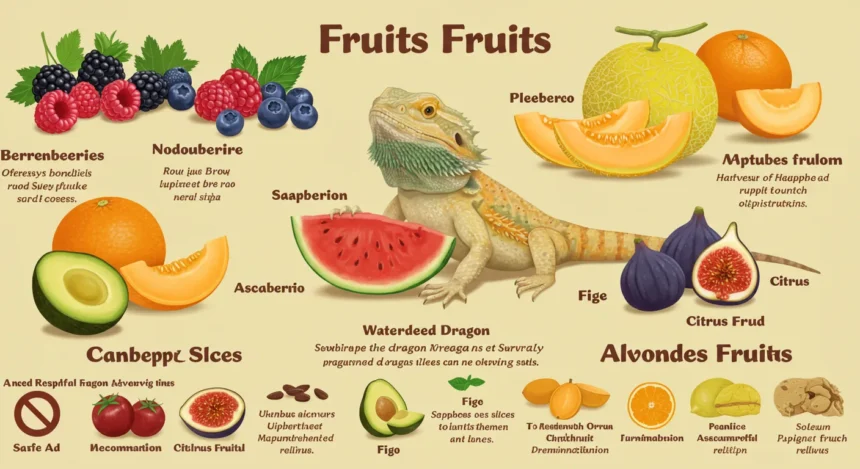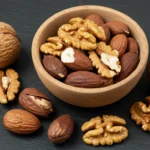Table of Contents
Bearded dragons are fascinating pets, and knowing what fruits can bearded dragons eat is key to keeping them healthy and happy. This guide explores safe fruits, feeding tips, and foods to avoid, ensuring your bearded dragon thrives.
Understanding Bearded Dragon Diets
Bearded dragons need a balanced diet tailored to their age. Juveniles and adults have different nutritional needs, which impacts fruit choices.
- Juvenile Diet: Baby bearded dragons require 80% insects and 20% plants, including fruits. Their growing bodies need protein from bugs.
- Adult Diet: Adults, around 18 months, flip to 80% plants and 20% insects. Fruits remain a small but important part.
Why Fruits Matter in Moderation
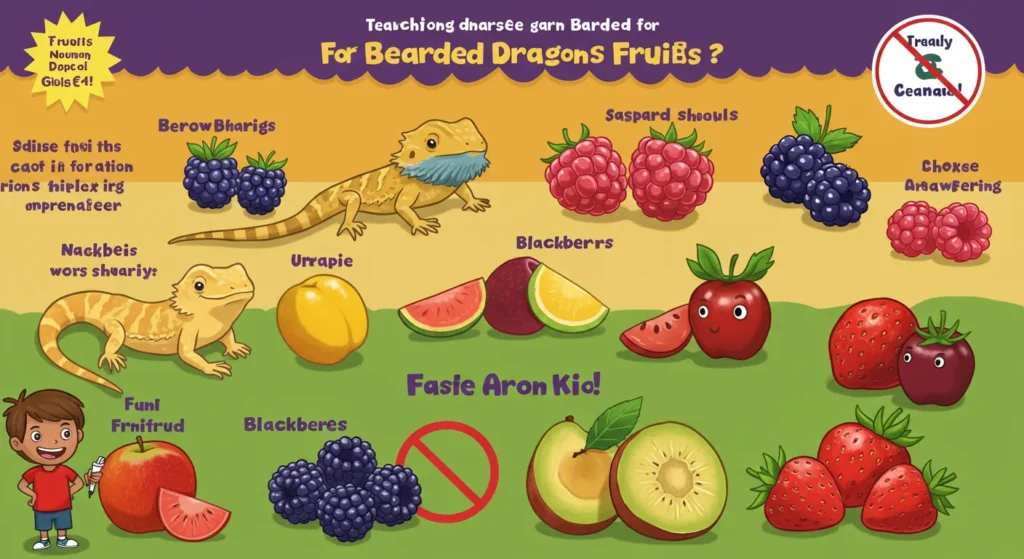
Fruits add variety to a bearded dragon’s diet but should only be 5–10% of their intake. Overfeeding fruits, high in sugar, can lead to obesity or digestive issues.
- Portion Control: Use a gram scale to measure portions. For example, one to two grapes once or twice a week is enough.
- Frequency: Offer fruits sparingly, not daily, to avoid loose stools. Moderation keeps your pet healthy.
Safe Fruits for Bearded Dragons
Some fruits are safe and beneficial when fed correctly. Here are top choices with their nutritional perks.
- Grapes: Packed with over 1,600 compounds like potassium and antioxidants, grapes have an excellent calcium to phosphorus ratio. Dark red or purple grapes offer more antioxidants than green ones.
- Apples: These have a healthy calcium to phosphorus ratio. Remove seeds and cut into small pieces to prevent choking.
- Strawberries: Composed of 45% to 68% water, strawberries hydrate but have slightly more phosphorus than calcium. Feed sparingly, like once a week.
Fruits to Limit or Avoid
Not all fruits are safe due to high phosphorus, oxalates, or acidity. Limiting these protects your bearded dragon from health issues.
- Bananas: High in phosphorus, bananas block calcium absorption, risking Metabolic Bone Disease (MBD). Offer only as a rare treat.
- Mangos: These contain too much phosphorus and moderate oxalates, which can harm kidneys. Use cautiously, in tiny amounts.
- Citrus Fruits: Oranges and grapefruit are too acidic, causing stomach pain or gastrointestinal upset. Avoid them entirely.
The Importance of Calcium to Phosphorus Ratio
A proper calcium to phosphorus (C:P) ratio, ideally 1.1 to 2.1, is critical for bearded dragons. Imbalanced ratios can lead to serious health problems.
- Why It Matters: High phosphorus prevents calcium absorption, increasing the risk of MBD, a painful condition. For example, peaches have a poor 1:3 C:P ratio, making them less ideal.
- Safe Choices: Stick to fruits like grapes or apples with better ratios. Always check nutritional content before feeding.
Preparing Fruits for Your Bearded Dragon
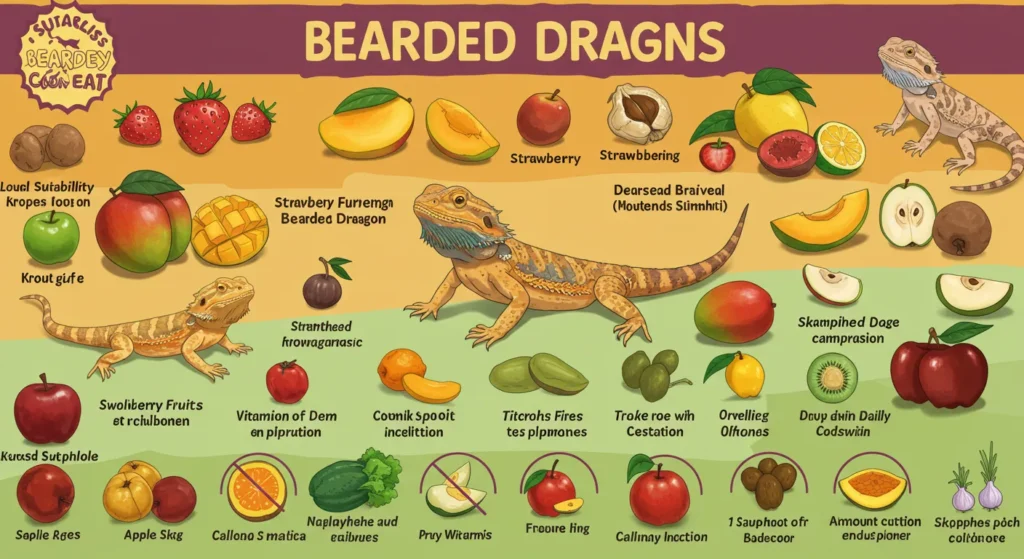
Proper preparation ensures fruits are safe and easy to eat. Follow these steps for worry-free feeding.
- Wash Thoroughly: Rinse fruits to remove pesticides or dirt. Organic options are best when possible.
- Remove Seeds and Pits: Large seeds or pits, like those in apples or peaches, can cause blockages. Always remove them.
- Chop Finely: Cut fruits into small, bite-sized pieces. This prevents choking and aids digestion.
Feeding Frequency and Timing
Bearded dragons have specific feeding schedules to maintain health. Timing and duration matter for fruits and other foods.
- Twice Daily for Adults: Adult bearded dragons typically eat twice a day. Offer fruits during one of these meals, sparingly.
- Time Limits: Leave fruits in the enclosure for about 30 minutes to avoid overfeeding or mold. Remove uneaten portions promptly.
Toxic Foods to Avoid Completely
Some foods are dangerous and can harm or kill your bearded dragon. Knowing what to avoid is as important as knowing safe fruits.
- Avocados: High acid content makes avocados toxic. Even small amounts can cause severe injury.
- Rhubarb: Its extremely poor C:P ratio makes it toxic. Never feed rhubarb to your pet.
- Chocolate and Dairy: These are harmful and offer no nutritional value. Keep them far from your dragon.
- Wild Insects: Avoid feeding wild-caught bugs. They may carry diseases or parasites that can be deadly.
Combining Fruits with Other Foods
Fruits should complement a diet rich in vegetables and insects. Pairing them wisely enhances nutrition.
- Vegetables: Carrots, with good vitamin A and C:P ratios, pair well with fruits like apples. Celery, with moderate oxalates, should be limited to avoid kidney issues.
- Insects: For juveniles, prioritize insects like crickets, leaving them in the enclosure for up to 10 minutes. Adults need fewer insects but still benefit from them alongside fruits.
Tips for a Balanced Bearded Dragon Diet
A balanced diet keeps your bearded dragon healthy and active. Here are practical tips to follow.
- Variety: Rotate safe fruits like grapes, apples, and strawberries to keep meals interesting. Avoid over-relying on one fruit.
- Monitor Health: Watch for signs of digestive issues, like loose stools, which may indicate too much fruit. Adjust portions if needed.
- Supplements: Dust fruits and veggies with calcium powder to boost nutrition. This helps prevent MBD, especially in juveniles.
Common Mistakes to Avoid
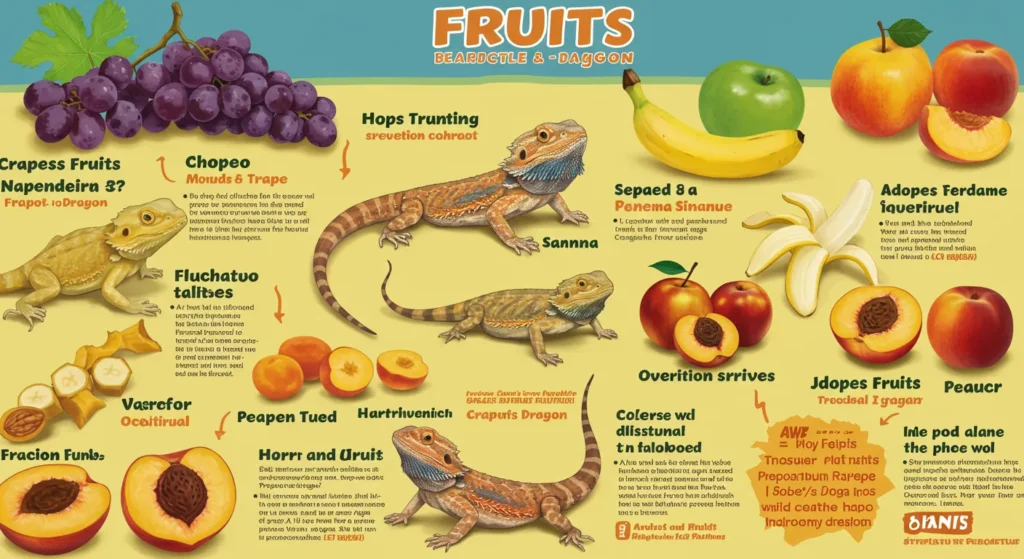
New bearded dragon owners often make feeding errors. Avoiding these ensures your pet’s well-being.
- Overfeeding Fruits: Too many fruits, like bananas or mangos, can cause health issues due to sugar or phosphorus. Stick to the 5–10% rule.
- Ignoring Ratios: Feeding fruits with poor C:P ratios, like peaches or sweet potatoes, risks MBD. Always prioritize calcium-rich options.
- Skipping Prep: Failing to remove seeds or chop fruits can lead to choking or blockages. Take time to prepare food properly.
Real-Life Example: A Bearded Dragon’s Diet Plan
Consider Bella, a one-year-old bearded dragon transitioning to an adult diet. Her owner learned the hard way that overfeeding bananas caused loose stools, so they switched to grapes and apples, offered twice weekly in small portions, alongside carrots and crickets, keeping Bella healthy and energetic.
Final Thoughts
Knowing what fruits can bearded dragons eat helps you provide safe, healthy treats for your pet. Stick to fruits like grapes and apples, prepare them carefully, and avoid toxic foods like avocados to ensure your bearded dragon thrives. Always monitor portions and balance fruits with vegetables and insects for a happy, healthy dragon. For more tips, consult a vet or trusted pet care resources.
FAQs
What fruits are safe for bearded dragons to eat?
Grapes, apples, and strawberries are safe in moderation. They offer good nutrients but should be 5–10% of the diet. Always remove seeds and chop finely.
How often can I feed fruits to my bearded dragon?
Offer fruits once or twice a week, not daily. Limit to small portions, like 1–2 grapes, to avoid obesity or digestive issues due to high sugar.
Why is the calcium to phosphorus ratio important?
A 1.1 to 2.1 ratio prevents Metabolic Bone Disease. High phosphorus in fruits like bananas can block calcium, so choose fruits like grapes.
Can bearded dragons eat bananas?
Bananas are high in phosphorus and should be a rare treat. Overfeeding risks calcium deficiency, leading to health issues like MBD.




